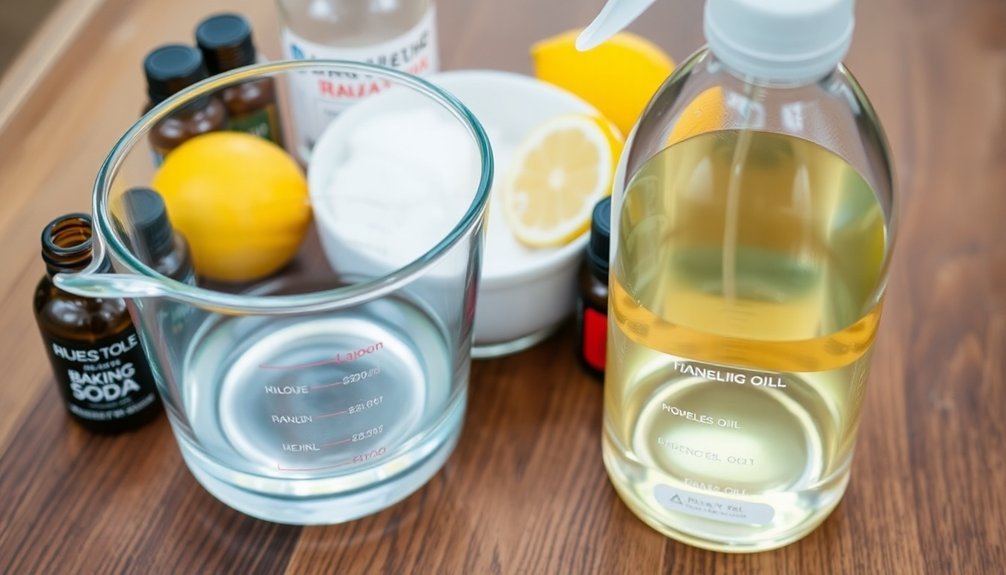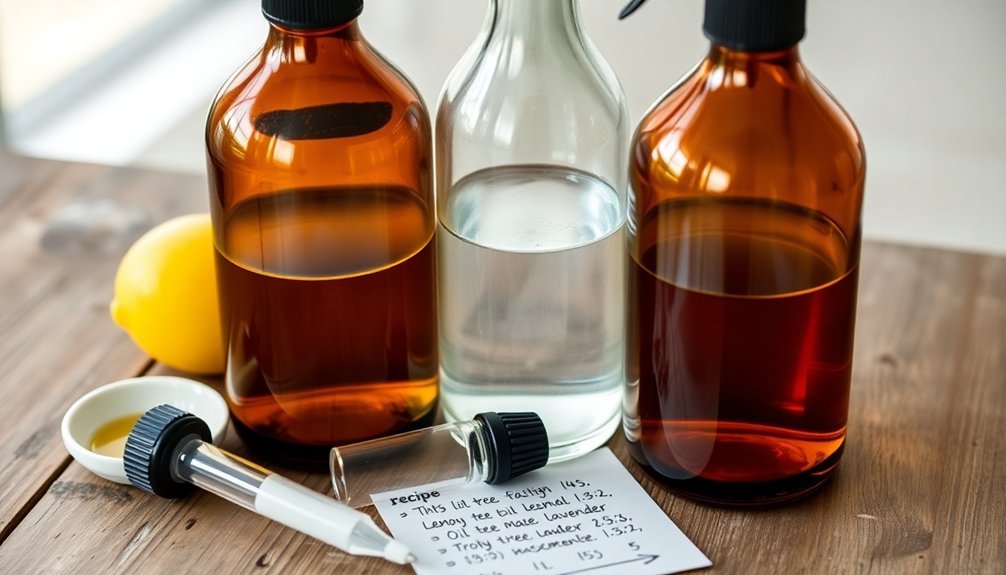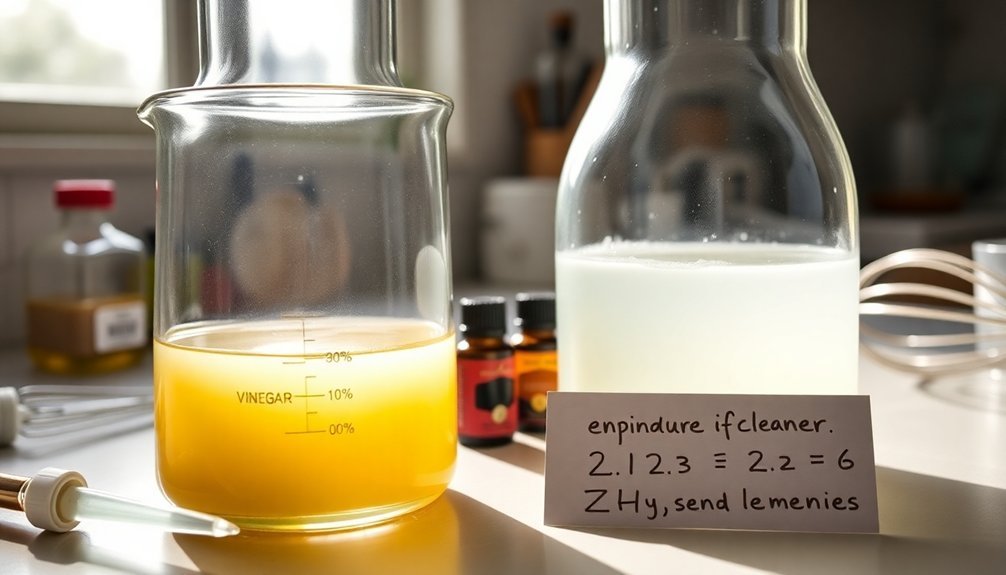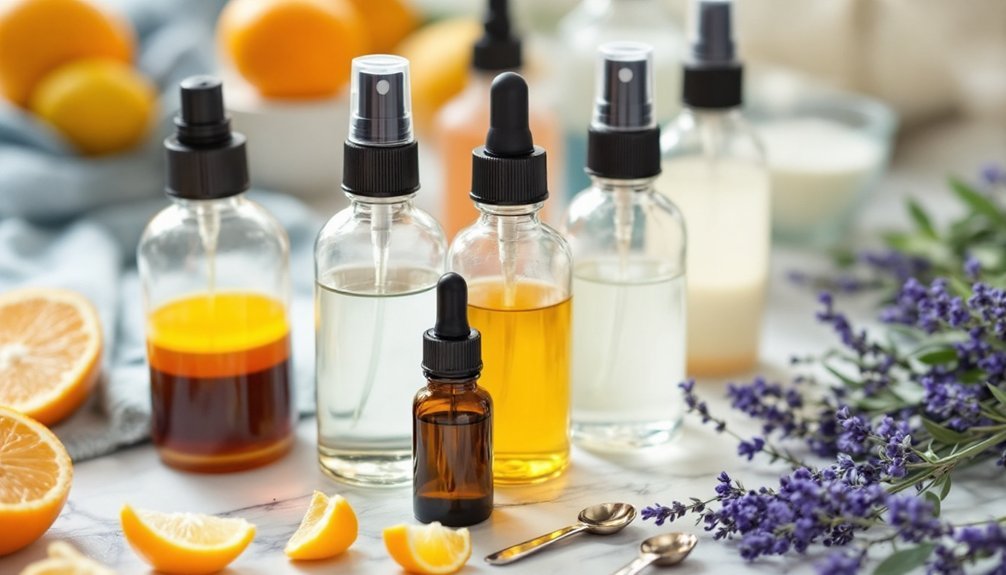Oil ratios in handmade cleaners impact more than just fragrance—they determine cleaning effectiveness and safety. Proper proportions prevent greasy residue while ensuring adequate cleaning power by creating stable emulsions. You'll need approximately 1% essential oil concentration (20-30 drops per 16oz) for effective results without harming surfaces or pets. Different surfaces require specific ratios: wooden surfaces benefit from 1:2 oil-to-vinegar, while bathrooms need less oil and more washing soda. Master these balances for truly effective DIY cleaning solutions.
What Makes Oil Ratios Matter In Handmade Cleaners?

When crafting your own household cleaners, the balance of oils you incorporate isn't just about fragrance—it's the foundation of effectiveness.
The precise ratio of oils determines how well your cleaning products will perform on various surfaces. If you've ever noticed a greasy film after using a homemade cleaner, you've witnessed the consequences of imbalanced oil proportions.
Too much oil leaves residue, while too little fails to provide adequate cleaning power. A well-calibrated formula creates the perfect emulsion, allowing water and oil-based ingredients to work together rather than separate.
Essential oils contribute more than just pleasant scents—they offer specific cleaning properties that can enhance your formula's performance, especially when properly balanced for safety around children and pets.
Understanding Oil Properties in Cleaning Formulations
Before mixing your homemade cleaners, you'll need to understand each oil's unique properties as they function like specialized tools in your cleaning arsenal.
Different oils contribute specific benefits to your cleaning formulations—tea tree oil enhances disinfecting power, while olive and coconut oils add conditioning effects that nourish wooden surfaces.
Essential oils don't just provide pleasant scents; they actively participate in the cleaning process. Some cut through grease effectively, while others maintain ideal pH balance for surface protection.
You'll need to adjust your oil ratios carefully—too much oil creates residue, while too little reduces cleaning effectiveness.
The Science Behind Effective Oil-to-Water Ratios

You'll find that emulsion stability depends on achieving the right balance between oil and water molecules at the microscopic level.
When you mix oils with water in your homemade cleaners, surfactants reduce surface tension, allowing the tiny oil droplets to remain suspended rather than separating.
This careful equilibrium creates a more effective cleaner that maintains its consistency while maximizing the oil's dirt-encapsulating properties.
Emulsion Stability Factors
Although making homemade cleaners seems straightforward, the science of emulsions governs their effectiveness and longevity. When you're mixing oil-based ingredients with water, you're creating an emulsion that needs to remain stable to be effective.
The foundation of emulsion stability lies in proper oil-to-water ratios, typically starting at 1:4. This balance guarantees your cleaner won't separate quickly after mixing. Adding surfactants like Castile soap dramatically improves stability by reducing tension between the oil and water phases.
Don't overlook your mixing technique—using a blender or vigorously whisking creates smaller oil droplets that stay suspended longer. Temperature also matters; extreme heat or cold can destabilize your mixture.
When adding ingredients like vinegar or essential oils, you'll need to test and adjust your ratios to maintain that perfect balance.
Surface Tension Dynamics**
Surface tension explains why oil and water naturally resist mixing in your homemade cleaners. This elastic-like force at their interface creates barriers that must be overcome to achieve proper emulsification.
When you adjust your oil-to-water ratio correctly, you're manipulating this tension to your advantage. Higher oil concentrations strategically reduce surface tension, allowing your cleaner to penetrate surfaces more effectively and lift away dirt and grime.
The ideal balance directly impacts how well your cleaning solution performs – too little oil won't break tension adequately, while too much creates separation issues. The right ratio creates a fluid consistency that works perfectly in spray bottles without clogging.
Balancing Cleansing Power and Surface Protection
When crafting homemade cleaners, achieving the perfect balance between cleaning efficacy and surface protection depends largely on your oil ratios. The standard 1:2 ratio of vinegar to oil creates an effective cleaner that cuts through grime while simultaneously nourishing surfaces.
You'll need to adjust these oil ratios based on your cleaning target. Wood surfaces require higher oil content to prevent stripping of natural finishes, while non-porous surfaces need less oil to avoid residue buildup.
Remember that excessive vinegar can damage protective finishes, while insufficient cleansing oils won't effectively remove dirt.
Don't overlook essential oils—they're more than just fragrance. Adding them at approximately 1% of your total mixture provides antibacterial benefits without compromising your cleaner's primary function.
This careful balance guarantees peak cleansing power while maintaining proper surface protection.
How Oil Ratios Affect Product Stability and Shelf Life

When creating your homemade cleaners, you'll find that proper oil ratios directly affect emulsion stability, preventing separation that can compromise effectiveness.
You can inhibit bacterial growth by incorporating essential oils with antimicrobial properties at the recommended 1-5% concentration, extending your product's usable life.
Your cleaner's longevity also depends on controlling oxidation rates through balanced combinations of stable carrier oils like olive oil with more volatile ones, which helps maintain consistent performance over time.
Emulsion Formation Dynamics
Achieving the perfect balance of oils in your handmade cleaners directly impacts how stable your product will remain over time. When you combine oil and water components, they naturally want to separate, but proper oil ratios prevent this separation, ensuring your cleaner maintains consistency throughout its use.
The science behind emulsion formation involves creating a delicate equilibrium—typically between 1:3 and 1:5 oil-to-water. Too much oil leaves a greasy residue, while too little diminishes cleaning efficacy. Emulsifiers like vegetable glycerin play an essential role by binding oil and water molecules together, extending shelf life considerably.
You'll notice that well-formulated emulsions not only clean better but also provide a more pleasant sensory experience, with improved texture and scent release during use.
Bacterial Growth Prevention
Beyond the aesthetics and cleaning power of your handmade cleaners, the proper ratio of oils directly impacts how resistant your product will be to bacterial contamination. Higher oil concentrations without appropriate antibacterial agents can create perfect environments for microbial growth, compromising safety and effectiveness.
Essential oils play a significant role in your formulation's shelf stability. When balanced properly with carrier oils, they provide:
- Natural antimicrobial properties that inhibit bacterial proliferation
- Protection against rancidity, especially important when using unsaturated oils like flaxseed
- Extended shelf life without synthetic preservatives
You'll need to be particularly careful with highly unsaturated oils, as they're prone to oxidation and can develop off-smells quickly.
The right balance creates cleaners that remain effective and safe throughout their intended lifespan.
Oxidation Rate Control
The lifespan of your handmade cleaners hinges critically on how you manage oil oxidation rates within your formulations. Oils with higher unsaturated fatty acid content deteriorate faster, so balancing these with more stable options like olive oil can greatly extend shelf life.
When incorporating essential oils for fragrance or cleaning properties, you'll need to carefully calculate their ratio to carrier oils. While they enhance your product's effectiveness, they accelerate oxidation when used excessively.
Consider adding antioxidants like vitamin E in appropriate proportions to slow the oxidation process.
You should also routinely check your products for changes in color, smell, or texture as indicators of oxidation.
Essential Oil Concentrations for Safe Yet Effective Cleaning

When creating homemade cleaners with essential oils, maintaining the proper concentration is crucial for both safety and effectiveness. Your cleaning spray should contain approximately 1% essential oil concentration—translating to 20-30 drops in a standard 16 oz bottle.
This careful balance guarantees your cleaner works efficiently without posing risks to your family or pets. Remember that certain oils like tea tree can be toxic to animals if used excessively.
To maximize safety and effectiveness:
- Test your cleaner on a small, inconspicuous area before using throughout your home
- Monitor your homemade solutions regularly, as essential oils degrade over time
- Adjust concentrations based on specific surfaces and cleaning needs
Measuring and Calculating the Perfect Oil Blend
Achieving the ideal oil blend in homemade cleaners requires precise measuring techniques and thoughtful calculations. When working with oil ratios, always measure ingredients in a well-lit area using proper measuring tools—not just eyeballing amounts.
For wood cleaners, start with the proven ½ cup vinegar to ¼ cup oil ratio, adjusting slightly based on your specific needs. Remember to limit essential oils to no more than 1% of your total mixture to prevent skin irritation while still capturing their antibacterial benefits.
Consider each oil's viscosity and scent strength when developing your cleaning recipes. Too much oil will leave surfaces greasy, while too little won't provide enough conditioning.
Test small batches first, noting how your blend performs on different surfaces before finalizing your formula.
Common Mistakes in Oil Proportioning and How to Avoid Them

Why do so many homemade cleaners fail to deliver results? Often, it's because of improper oil ratios. The oil you choose makes a significant difference in your cleaner's effectiveness.
When making your own cleaning solutions, watch out for these common pitfalls:
- Using excessive oil creates residue instead of cleaning surfaces – aim for balanced proportions that allow for easy wiping.
- Choosing incompatible oils without considering their properties – heavier oils won't behave like lighter ones in the same formula.
- Adding undiluted essential oils can cause irritation – always follow recommended dilution rates for safety.
Don't overlook how oils interact with other ingredients, which can cause separation in your mixture.
Remember that volatile oils evaporate over time, potentially reducing your cleaner's effectiveness throughout its shelf life.
Adjusting Ratios for Different Cleaning Applications
When creating cleaners for different surfaces, you'll need to adjust your oil-to-vinegar ratios to maintain the perfect balance between cleaning power and safety.
For wooden surfaces, stick with a 1:2 oil-to-vinegar ratio to protect the wood while still cutting through grime, whereas bathroom surfaces benefit from less oil and more washing soda to combat stubborn soap scum.
You can safely increase essential oil concentrations up to 2% when you need stronger fragrance or antibacterial properties, but exceeding this threshold might cause irritation or leave residues on your surfaces.
Balance for Different Surfaces
The perfect oil ratio in your homemade cleaners varies considerably depending on the surface you're tackling. For delicate surfaces like wood furniture, you'll want to use less oil—about ¼ cup olive oil mixed with vinegar prevents buildup while nourishing the wood.
Tough surfaces like stainless steel appliances can handle higher oil ratios to cut through stubborn grease and grime.
When balancing your formulations, consider:
- Surface porosity—porous materials need less oil to avoid oversaturation
- Frequency of cleaning—high-traffic areas require non-sticky formulations with lower oil content
- Environmental factors—humidity levels affect how surfaces absorb and retain oils
Finding the right balance guarantees your cleaner won't leave streaks or residue.
You'll know you've achieved the perfect oil ratio when surfaces are clean, appropriately moisturized, and free of any sticky film.
Effectiveness Versus Safety
Finding the right oil balance for surfaces is only part of the equation—you must also consider how oil ratios impact both cleaning power and safety concerns. A standard 1% concentration of essential oils works well for most all-purpose cleaners, providing effective cleaning without risking skin irritation.
When tackling tougher jobs, you might be tempted to increase oil ratios for stronger antimicrobial effects. However, this approach requires caution, especially in homes with children or pets. Higher concentrations of oils like tea tree can clean more effectively but may pose safety risks if used improperly.
Start by testing small batches with varying oil ratios to find your ideal balance. Remember that too much oil creates residue buildup, while too little won't clean effectively.
Your goal is finding that sweet spot where your cleaner works powerfully yet safely.
The Impact of Carrier Oils on Cleaning Performance
Selecting the right carrier oils for your homemade cleaners can dramatically affect their performance on various surfaces. The ratio between oils like olive oil and vinegar creates a balance that optimizes cleaning power while providing conditioning benefits. High-quality carrier oils enhance cleaning performance without the toxicity of petroleum-based alternatives found in commercial products.
When formulating your cleaner, consider:
- Olive and avocado oils offer superior stability and longer shelf life, preventing your mixture from going rancid quickly.
- A proper balance prevents residue while maintaining adequate lubrication for surfaces.
- Essential oils should compose about 1% of your formula to add disinfecting properties without overwhelming carrier oils' functions.
You'll achieve better results by understanding how carrier oils interact with other ingredients, creating cleaners that effectively cut through grime while nourishing surfaces.
Testing Methods to Verify Optimal Oil Ratios
Once you've developed a homemade cleaner formula, verifying its effectiveness requires systematic testing to confirm you've achieved the ideal oil ratio.
Start by conducting small batch experiments to assess cleaning effectiveness on various surfaces before scaling up your recipe.
Use pH testing strips to verify your cleaner won't damage sensitive materials, and observe how different oil ratios affect consistency and scent.
Watch for separation or unusual changes that might indicate imbalance.
Document each test batch methodically, noting the specific oil ratios and their performance results.
Consider recruiting family and friends for user trials to gather real-world feedback on your formulations.
Their insights on cleaning power and fragrance preferences will help you refine your recipe until you've created the perfect balance for your needs.
Seasonal Adjustments to Oil Formulations
As seasons change throughout the year, your homemade cleaners will need corresponding adjustments to maintain peak performance.
Temperature fluctuations greatly affect oil viscosity, requiring thoughtful modification of oil ratios in your household cleaning formulations.
During colder months, reduce thicker oils like olive oil to prevent your cleaner from becoming too stiff and difficult to apply.
When temperatures rise, you'll want to increase lighter oils such as grapeseed or jojoba to enhance fluidity.
Consider these seasonal adjustments:
- In winter, decrease heavy oil content by 10-15% to maintain spreadability
- During humid summers, add 3-5 more drops of essential oils to preserve scent potency
- For spring cleaning, incorporate more citrus oils for enhanced grease-cutting power
These modifications guarantee your cleaners remain effective regardless of weather conditions.
Frequently Asked Questions
How to Make Homemade Cleaning Products That Smell Good?
You'll create great-smelling homemade cleaners by adding 20-30 drops of essential oils like lavender or tea tree to 16 oz of solution. Mix with vinegar and lemon juice for fresh scents that clean effectively.
What Do Different Oils Do in Soap Making?
In soap making, different oils serve unique functions. You'll find coconut oil creates bubbles, olive oil conditions your skin, some oils harden your bars, and others extend shelf life. Each contributes distinct properties to your final soap.
What Are the Best Essential Oils for Homemade Cleaners?
For homemade cleaners, you'll find tea tree, lavender, lemon, and peppermint oils most effective. They'll disinfect surfaces, cut through grease, repel insects, and leave invigorating scents while being naturally antibacterial and deodorizing.
Can You Mix Vinegar and Tea Tree Oil for Cleaning?
Yes, you can mix vinegar and tea tree oil for cleaning. This powerful combination disinfects surfaces effectively. Use about 10 drops of tea tree oil per cup of vinegar, and always test on inconspicuous areas first.
In Summary
When you master oil ratios in your handmade cleaners, you'll achieve better results and longer-lasting products. Remember that different surfaces and cleaning goals require specific formulations. Don't be afraid to adjust your recipes seasonally or test small batches before scaling up. With practice, you'll develop an intuitive understanding of how oils interact with other ingredients to create effective, stable cleaning solutions.





Leave a Reply